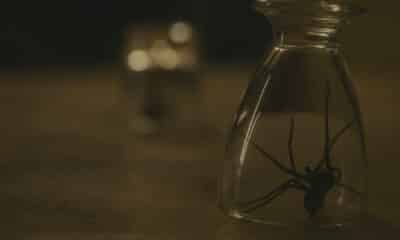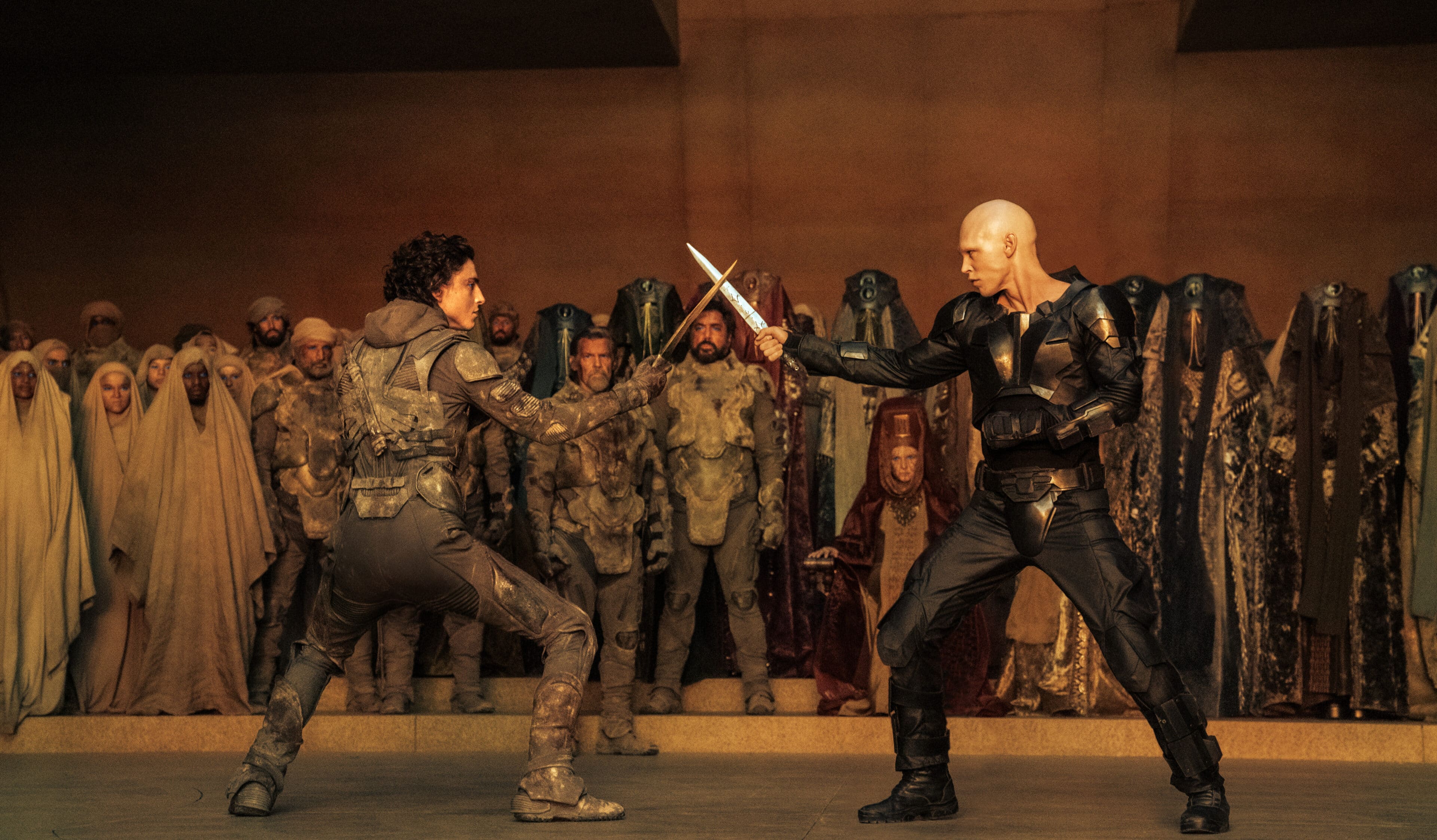I cannot wait to see GRAVITY. James Cameron has said it is the best space film he has ever seen and, seeing how successful the film has been in the US, I’m inclined to believe the mad old solo-submarining geezer. From the moment I saw the first trailer for it before THE WOLVERINE back in August, there has been no film I have anticipated more. Except THE HOBBIT, but that’s a given and can therefore be excluded.
The concept of characters stranded in space with nothing but their space suits to protect them from the void outside fascinates me. I love films in which a single character or a small group of characters become isolated and trapped in a seemingly inescapable situation, as they allow for an exploration of the human nature in an honest and realistic way that other films cannot. These films range from the positive and uplifting, such as 127 HOURS, to the dark and chilling, such as THE DIVIDE. Both are worth your time.
Then there is BURIED which, despite the camera never leaving the constraints of a wooden coffin for the film’s 90-minute duration, remains one of the tensest and most harrowing films I have ever seen. The film has one set that is lit completely naturally with a lighter and a phone screen, yet in those confines Ryan Reynolds created a character more believable and human than many of those in globe-spanning blockbusters.
I also had an immediate attraction to GRAVITY as it shares its core principle with my favourite short story – Kaleidoscope by Ray Bradbury. Much like GRAVITY, the story begins with a spaceship being hit, hurling the crew into the abyss of space:
‘The first concussion cut the rocket up the side with a giant can-opener. The men were thrown into space like a dozen wriggling silverfish. They were scattered into a dark sea; and the ship, in a million pieces, went on, a meteor swarm seeking a lost sun.
“Barkley, Barkley, where are you?”
The sound of voices calling like lost children on a cold night.
“Woode, Woode!”
“Captain!”
“Hollis, Hollis, this is Stone.”
“Stone, this is Hollis. Where are you?”
“I don’t know. How can I? Which way is up? I’m falling. Good God, I’m falling.”’
The astronauts spread quickly, each flying in a different direction. They can talk to each other through their radios until they get out of range, then they await their deaths alone. In this last conversation, they fear and fight. They discuss life and its meaning. They experience the universe’s wonder. They forgive. And then, as Hollis floats towards Earth, out of radio contact and despairing about his empty existence, he finds meaning in a small thought that gives the story a truly beautiful and humbling ending.
It is the potential of such a story that is the reason I am so excited for GRAVITY. The other big draw for me is the film’s emphasis on realism. The director, Alfonso Cuarón, strived to make everything accurate in terms of the physics of space. ‘Kaleidoscope’, written in the 50s, is impressive in that it got some things right. When in space, for example, you are essentially falling very fast. Like many sci-fi authors however, Bradbury also got his fair share of things wrong, such as the ability to hold one’s breath when exposed to space’s vacuum.
In contrast to GRAVITY, countless films also do space wrong. But does it matter? Let’s have a look at some of the biggies.
SOUND, EXPLOSIONS, FIRE AND EXPLOSIONS
Offenders: STAR WARS, STAR TREK, ARMAGEDDON, ALIEN
‘In space, no one can hear you scream’. The immortal tagline of Ridley Scott’s 1979 classic ALIEN. Aside from the fact that it doesn’t strictly fit the film, as others in the same spaceship could hear you, the line conveys isolation in reference to sound’s inability to travel through a vacuum.
Sound waves are propagated by vibrating molecules of solid, liquid or gas, with each molecule passing a vibration, determinate of the wave’s frequency, onto the next. When they reach the flappy things on the sides of our heads, the waves vibrate our inner ear hair cells at the same frequency and signals are sent to brain, creating the sound that we hear.
With the exception of when we are underwater, or encased in something solid (let us all hope this never happens to any of us), sound generally travels through air. Therefore in space, where there is no air to vibrate, waves cannot get to our ears and so ‘sound’, as our brain knows, it cannot exist. Well, that’s not entirely true. There are other gases present in space that are capable of carrying sound waves, but these gas particles are so scattered that the sound would require ears far more sensitive than our own to hear. So, for the sake of this article and all that is holy, let’s just say there is no sound in space.
As well as predicting Skype, Stanley Kubrick did sound (or lack thereof) right in his legendary 1968 film 2001: A SPACE ODYSSEY. When the artificially intelligent HAL refuses to open the pod bay doors (ask the question to Siri, it’s hilarious) to get back inside the ship, astronaut Dave Bowman uses decompression to fire himself into an airlock minus a spacesuit (we’ll come back to this later). This plays out in complete silence, with sound returning once the airlock had filled with air. I bow to thee, Kubrick.
The cult television show FIREFLY and its feature-length follow-up SERENITY also accurately portrayed the silence of space. And, striving to be the most realistic and immersive space experience (aside from actually sending audiences into space), GRAVITY is going one step further by featuring sound in space only when a character is touching the object that is making the sound, allowing the vibrations to travel through their bodies (clicky for more, yo).
Many space films aren’t as interested in accuracy. In the STAR WARS series, lasers squeal as they rip through space and the Death Star explodes not once, but twice, its destruction accompanied on both occasions by a universe-shattering BOOM. STAR TREK is equally guilty and ALIEN amusingly disregards its clever tagline by having the Nostromo loudly self destruct. LOL. This is in fact a double sin as explosions are chemical reactions that require – yep, you guessed it – oxygen. Fire in space is impossible, yet it still shows up in a load of films including ARMAGEDDON, MOONRAKER, SUNSHINE and a list of others almost as long as Santa’s. But are these sins worth seeing a priest about?
Of course not (but that other thing you did probably is). A massive, action-packed hulk of a film like STAR WARS needs big sound and big things blowing up. When a ridiculous spaceship battle is playing out on screen, having that audio feedback bombarding your ears is part of the experience. It is scientifically proven (citation needed) that people love seeing things blow up. To put it simply, it makes it more fun to watch; a lot of films would rather be fun than realistic and I, for one, am perfectly fine with that.
BEING IN SPACE WITHOUT A SUIT (YOU’D HAVE TO BE A NUTTER)
Offenders: 2001: A SPACE ODYSSEY, SUNSHINE
Now this is something that’s approached differently between films. Returning to the scene in 2001 I mentioned earlier, Dave holds his breath as he shoots into the airlock and aside from getting a couple of bruises he is perfectly fine. In Danny Boyle’s SUNSHINE on the other hand (my favourite film of all time), space will very quickly freeze you to death, a process which can be slowed by wrapping oneself in insulated tin foil stuff and curling up.
But what really happens to you if you are exposed to space without a suit? Well, we know you wouldn’t be able to hold your breath, so that puts 2001 firmly in Camp Wrong. As there is no pressure in space, the vacuum would pull all of the air in your lungs and intestines out of your body, through your mouth and anus (yes, it would be tremendously messy).
You also wouldn’t freeze, despite the universe being -270°celcius (2.7 Kelvin). Your body heat would actually stay inside as there is nothing on the outside to conduct it out of you. So that rules SUNSHINE out of the pages of realism, along with bonsai kittens, double jumps and the Tooth Fairy (on a side note I found out the Tooth Fairy wasn’t real from a children’s book about two chimps called Bangers and Mash).
Other theories proposed in sci-fi include the body exploding, due to a huge difference between internal and external pressure, and the blood boiling. The latter was theorised as the boiling points of liquids get lower as air pressure decreases, so it was proposed that liquids in space would boil at body temperature as there is no air pressure. Both of these are incorrect as the inside of the body is made up of contained systems that are themselves not exposed to space.
What would happen is that you would lose consciousness in under 20 seconds and suffocate to death from lack of oxygen. It’s that simple and that boring. Oh, and your surface blood vessels would burst horribly. That’s just not cricket.
Sick as it sounds, though, weird space deaths are bloody great and I wouldn’t want them to go away for the world.
LIGHT SPEED AND LASER GUNS (TOGETHER FOR CONVENIENCE AND BECAUSE BOTH BEGIN WITH ‘L’)
Offenders: STAR WARS, MOONRAKER
The light speed effect in STAR WARS is iconic, with the stars stretching in a way that just looks damn cool. It is a shame then that, if we do ever find a way to travel at or near the speed of light (we’re not quite there yet), we would see something that’s completely different and not nearly as epic.
If you were to approach light speed, your field of view would increase, and everything would look like it was moving away from you. Thanks to the Doppler effect (the same thing that makes a police car siren change pitch when it hurtles past you in pursuit of some speeding idiot who is in no way as cool as he thinks he is, even with his face tattoo and trousers that are far too low, only in this case with light rather than sound), all light that reaches you would be blueshifted, shortening its wavelength. Unfortunately everything that was visible (including the lovely stars) would become invisible and instead you would only see the newly-visible (due to the blueshift), background cosmic radiation. It would look like this:
See? Boring.
Let’s move onto lasers, because why not. Again STAR WARS does these wrong, as well as other lasery space films like the Bond film MOONRAKER. Firstly, lasers always seem to be presented as brightly-coloured beams of light. Well, lasers are only visible if they hit something and reflect, which is generally something that ain’t gonna happen in space.
Secondly, considering lasers travel at the speed of light because, you know, they are light, any film in which a person or a spaceship dodges a laser is more wrong than those limited chili and chocolate crisps they released a number of years back (I kept a couple of sealed packs thinking they may become collector’s items before I realised who the hell would buy that crap and threw them all out because why the hell would I eat that crap).
Seriously though, a space battle film with realistic lasers would be naff. Screw reality, I want people dodging colourful things that go pew pew pew dammit!
GRAVITY DRIVES BUILT TO QUICKLY JUMP TO A FAR OFF PART OF SPACE GOING WRONG AND INSTEAD SENDING THE SHIP TO THE ACTUAL, REAL HELL
Offender: EVENT HORIZON
Let’s just move swiftly past this.
NO MOTION AND SLOW MOTION
Offenders: STARGATE, 2001: A SPACE ODYSSEY, SUNSHINE
This is the final part of this cinematic and scientific marathon. Soon you will be able to go back to combing your cat’s fur or watching that terrible music video made by Loughborough University.
There has been a common factor in the things that I have just discussed, which is the reason most of these errors exist. The vast majority of them are essentially wrong because they don’t consider the emptiness of space. There is no pressure, no air and therefore no resistance, so of course loads of films also get space motion wrong.
In the STARGATE franchise, among others of course, turning off a spaceship’s engine results in the vessel stopping. Of course, with no resistive forces applied to the ship as it moves forwards, it would continue to move after the propulsion from the engine has stopped. Simple mistake, but one that they make (I’m a poet and I already know it).
Additionally many films show people and objects moving through space in slow motion. This is wrong for the same reason. If you watch any of Commander Chris Hadfield’s brilliant YouTube videos from when he was up on the International Space Station, you’ll see he moves at a normal speed, despite floating and pratting around with toothpaste or something. This is common knowledge now, but even modern films ignore it. SUNSHINE’s director Danny Boyle knew that the type of motion in the film was inaccurate before he made it. So why did he do it?
When talking about SUNSHINE on the ‘Danny Boyle Retrospective’ featurette on the Blu-ray of his film TRANCE (not about space but an incredible film nonetheless), Boyle mentions that so many space films use slow motion now that if a film does it differently it kind of looks wrong in a cinematic context. However, he does defend the decision, talking about Kubrick’s use of slow motion as being an artistic and poetic choice.
We need to remember that filmmakers like Boyle and Kubrick are just that: filmmakers. Rather than trying to replicate reality, they are bringing their own creative vision to the screen and anyone who has seen 2001 would agree that motion is as integral to the film as everything else, from the music and audio to the look of the film.
So, the conclusion that I seem to be moving towards is that doing space wrong makes better entertainment – more fun, more exciting, more interesting to watch. We don’t question the time travel in BACK TO THE FUTURE or the science behind Richard Attenborough creating dinosaurs in JURASSIC PARK, so why should we question people exploding in space?
And finally we are back to GRAVITY. Am I suggesting it will be a terrible and boring film because it is realistic? Not at all. For STAR WARS we as an audience are the spectators, yet for GRAVITY we are there, floating in space with George Clooney and Sandra Bullock. The realism makes it all the more immersive. Will we see one of the characters’ blood vessels burst due to exposure? Maybe. What we will see, though, is a character study that only such a film can allow. And at least the film doesn’t involve Hell.
Who am I kidding, EVENT HORIZON is awesome.
GRAVITY will arrive in UK cinemas from Friday 8th November.

1 Comment
Leave a Reply
Leave a Reply
Latest Posts
-


Film Festivals
/ 14 mins ago‘The Buildout’ review: Dir. Zeshaan Younus [Panic Fest 2024]
In 2023 The Outwaters dominated independent horror. The found-footage, psychedelic nightmare, proved that you...
By Kat Hughes -


Film Reviews
/ 15 hours ago‘Boy Kills World’ review: Dir. Moritz Mohr (2024)
Bill Skarsgård is kicking off his 2024 slate strong with Boy Kills World. Directed...
By Kat Hughes -


Interviews
/ 15 hours agoInterview: Ricky Whittle discusses action film ‘Land of Bad’
Ricky Whittle is best known to the British public as having played Calvin Valentine...
By Kat Hughes -


Interviews
/ 15 hours agoInterview: Director Sébastien Vanicek on ‘Infested’ and directing the new ‘Evil Dead’
Sébastien Vanicek is a French writer and director who has recently been announced as...
By Kat Hughes






















Pingback: Doing Space Wrong | The Word of Tom